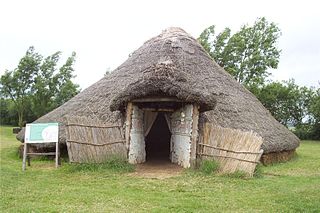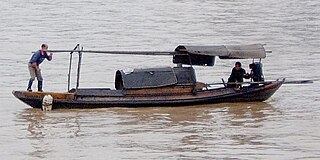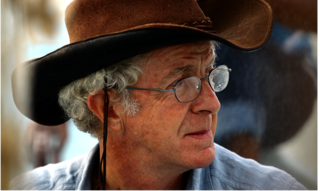
Carpentry is a skilled trade and a craft in which the primary work performed is the cutting, shaping and installation of building materials during the construction of buildings, ships, timber bridges, concrete formwork, etc. Carpenters traditionally worked with natural wood and did rougher work such as framing, but today many other materials are also used and sometimes the finer trades of cabinetmaking and furniture building are considered carpentry. In the United States, 98.5% of carpenters are male, and it was the fourth most male-dominated occupation in the country in 1999. In 2006 in the United States, there were about 1.5 million carpentry positions. Carpenters are usually the first tradesmen on a job and the last to leave. Carpenters normally framed post-and-beam buildings until the end of the 19th century; now this old-fashioned carpentry is called timber framing. Carpenters learn this trade by being employed through an apprenticeship training—normally four years—and qualify by successfully completing that country's competence test in places such as the United Kingdom, the United States, Canada, Switzerland, Australia and South Africa. It is also common that the skill can be learned by gaining work experience other than a formal training program, which may be the case in many places.

Flag Fen, east of Peterborough, England, is a Bronze Age site which was constructed about 3500 years ago and consists of more than 60,000 timbers arranged in five very long rows, creating a wooden causeway across the wet fenland. Part-way across the structure a small island was formed. Items associated with it have led scholars to conclude that the island was of religious significance. Archaeological work began in 1982 at the site, which is located 800 m east of Fengate. Flag Fen is now part of the Greater Fens Museum Partnership. A visitor centre has been constructed on site and some areas have been reconstructed, including a typical Iron Age roundhouse dwelling.

Dinghy sailing is the activity of sailing small boats by using five essential controls:

A sampan is a relatively flat-bottomed wooden boat found in East, Southeast, and South Asia. It is possibly of Chinese or Austronesian origin. Some sampans include a small shelter on board and may be used as a permanent habitation on inland waters. The design closely resembles Western hard chine boats like the scow or punt. Sampans are generally used for transportation in coastal areas or rivers and are often used as traditional fishing boats. It is unusual for a sampan to sail far from land, as they do not have the means to survive rough weather.

Pohela Boishakh is the Bengali New Year celebrated on 14 April in Bangladesh and 15 April in the Indian states of West Bengal, Tripura, Jharkhand and Assam. It is a festival based on the spring harvest—which marks the first day of the new year in the official calendar of Bangladesh.

Baytul Mukarrom, officially Baitul Mukarram National Mosque, is located at the center of Dhaka, the capital of Bangladesh. The mosque was completed in 1968. It has a capacity of more than 42,000 worshipers.

Noakhali, historically known as Bhulua, is a district in southeastern Bangladesh, located in the Chittagong Division. It was established as a district in 1821, and officially named Noakhali in 1868. The district's administrative center is situated in the municipality of Noakhali, also referred to as Maijdee, within Noakhali Sadar Upazila. Notably, Noakhali is the only district in Bangladesh that does not have a city named after itself.

Munshiganj, also historically and colloquially known as Bikrampur, is a district in central Bangladesh. It is a part of the Dhaka Division and borders Dhaka District.

Since 1976, through the Rolex Awards for Enterprise, Rolex has supported exceptional individuals who have the courage and conviction to take on major challenges; men and women who have a spirit of enterprise, initiating extraordinary projects that make the world a better place. Each winner receives 100,000 Swiss francs.

The culture of Bengal defines the cultural heritage of the Bengali people native to eastern regions of the Indian subcontinent, mainly what is today Bangladesh and the Indian states of West Bengal and Tripura, where they form the dominant ethnolinguistic group and the Bengali language is the official and primary language. Bengal has a recorded history of 1,400 years. After the partition, Bangladeshi culture became distinct from the mainstream Bengali culture, thus their culture evolved differently, still there are many commonalities in Bangladeshi culture & West Bengali culture which connects them both together as Bengali culture.

The Ma'agan Michael Ship is a well-preserved 5th-century BCE boat discovered off the coast of Kibbutz Ma'agan Michael, Israel, in 1985. The ship was excavated and its timber immersed in preservation tanks at the University of Haifa, undergoing a seven-year process of impregnation by heated polyethylene glycol (PEG). In March 1999, the boat was reassembled and transferred to a dedicated wing built at the Hecht Museum, on the grounds of the university. The boat has provided researchers with insights into ancient methods of shipbuilding and the evolution of anchors.
Friendship is a needs-driven non-governmental organisation that works in the Char islands and riverbanks of northern Bangladesh, the coastal belt in the south, and as of 2017, the Rohingya refugee camps in Ukhia, Cox's Bazar in the southeast. Established by Runa Khan in 2002, Friendship works to empower people through a sustainable, integrated development approach.

Taratari is a shipyard founded in 2004 in Bangladesh by the French sailor Yves Marre. Supported by the French NGO Watever, it aims to develop a modern, safe, and responsible nautical production industry in the country.

Yves Marre is a French entrepreneur, inventor and adventurer, co-founder of Friendship (NGO) in Bangladesh, co-founder of NGO Watever in France and creator of TaraTari Shipyard in Bangladesh.

Watever is a French Non-Governmental Association (NGO) composed of professionals from the maritime, transport, and development industries. It was established in 2010 by Marc Van Peteghem, Yves Marre, Alain Connan and Gérald Similowski with the conviction that boats can be a gateway to development. The NGO primarily focuses on underprivileged populations living on the shores of oceans and rivers, and provides them access to floating solutions uniquely adapted to their economic, social and climatic situation.

Nouka Baich is a traditional dragon boat-style paddling sport of Bangladesh. The Bangladesh Rowing Federation, established in 1974, is the authority of all rowing activities in Bangladesh and has organised over 40 National Rowing Championships. The races are held during the wet and autumn seasons of the Bengali calendar which corresponds from June to October in the Gregorian calendar. The "Nowka Bais" which takes place annually in Birmingham is a leading cultural event in the West Midlands, United Kingdom attracting not only the Bangladeshi diaspora but a variety of cultures. It is also the largest kind of boat race in the United Kingdom.

Runa Khan is a Bangladeshi social entrepreneur and the founder and executive director of Friendship NGO. Friendship is based on Khan's model of "integrated development," meaning it addresses problems in multiple sectors, including health, education, disaster management and economic development in communities where it is involved, rather than specializing in one of these. Khan won the Rolex Awards for Enterprise in 2006 for work through Friendship to preserve the declining craft of traditional boat building in Bangladesh.

Bengali traditional games are traditional games that are played in rural parts of the historical region of Bengal. These games are typically played outside with limited resources. Many games have similarities to other traditional South Asian games.

Folk music is one of the genres of music in Bangladesh. It is mainly Bengali's own music. This music talks about the lives of the people of rural Bengal, happiness, and sorrow. There are many parts to it again. It highlights the culture of a country or any region of the country.

























